Fiber Arts Take Over a Former Seaport Warehouse in NYC
See waterfalls of fabric, intricate threadwork, massive tapestries, and more!


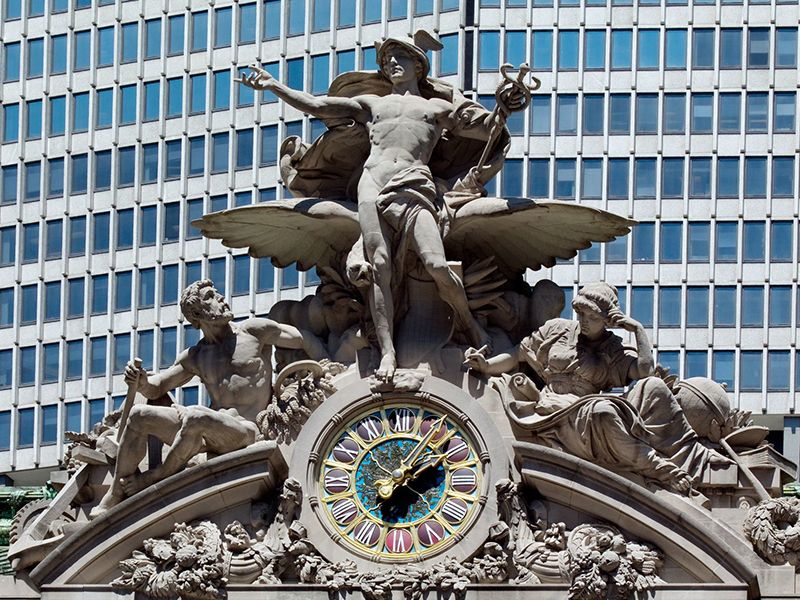
Before the advent of architectural modernism’s sleeker, less ornamental styles, architects commonly adorned the tops of buildings with human statues, particularly on municipal buildings. If you pause to glance up as you walk around New York, you might even catch a random statue — especially in lower Manhattan. Many of these statues originated during the early 20th century when the City Beautiful movement boomed. Here are a few statues that remain and, as expected with any art form, some modern twists on an old tradition.
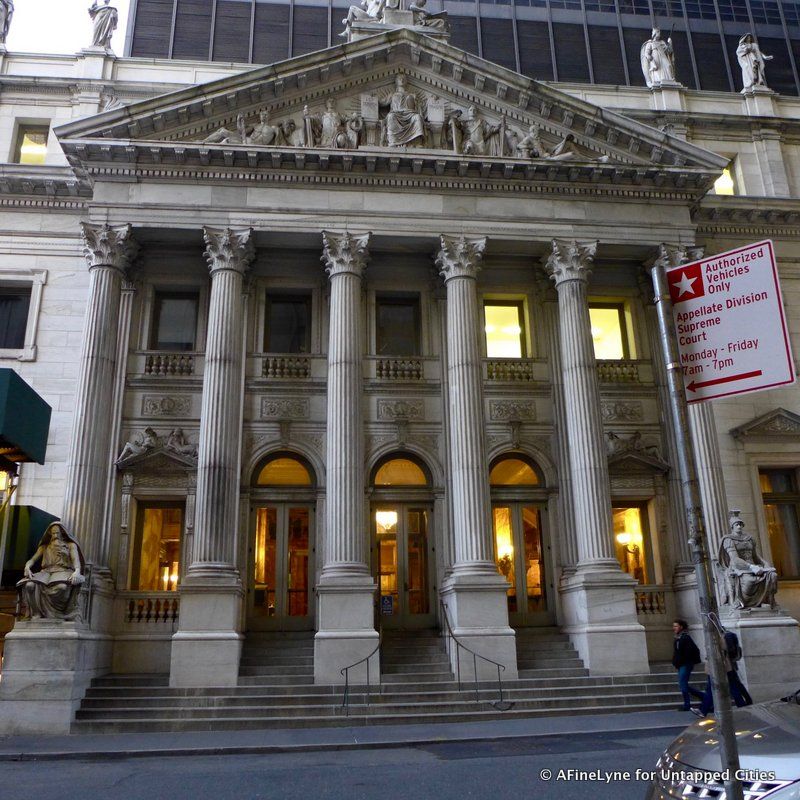
The collection of nine figures perched on the roof’s edge of the Appellate Division Courthouse of New York State represents history’s greatest legal thinkers. The figures include Confucius, Moses, Zoroaster, King Alfred the Great, Saint Louis, Manu, Lycurgus, Solon, and Justinian. A tenth statue depicting Lady Justice sits above the building entrance. Each of the nine statues was sculpted by a different artist, and the sculptors’ names are as impressive as their subjects. Among them are Daniel Chester French and Edward Clarke Potter who created the iconic New York Public Library lions.
When the courthouse was originally built in the 1890s, the collection included a statue of Mohammad, the founder of Islam. However, in 1955, the statue was removed at the request of the Egyptian, Pakistani and Indonesian governments because Islamic law prohibits images of the prophet. The statue has been lost to time.
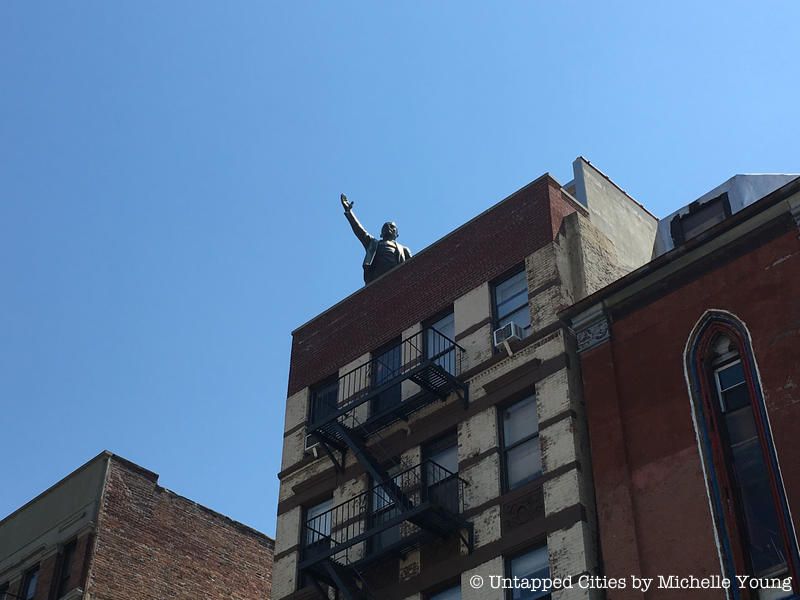
Where else would you expect to find a statue of the Russian revolutionary Vladimir Lenin but on Manhattan’s Lower East Side? New York real estate developers Michael Shaoul and Michael Rosen reportedly discovered this 18-foot likeness of Lenin in a backyard in Moscow. The developers had it shipped to New York and installed atop Red Square, a 130-unit building they developed in 1989 at 250 Houston Street.
In 2017, the developers moved the statue from Red Square to its present location, a tenement walkup just a few blocks away. Next to the statue’s new building is the Angel Orensanz Center, one of the oldest synagogues in New York City.
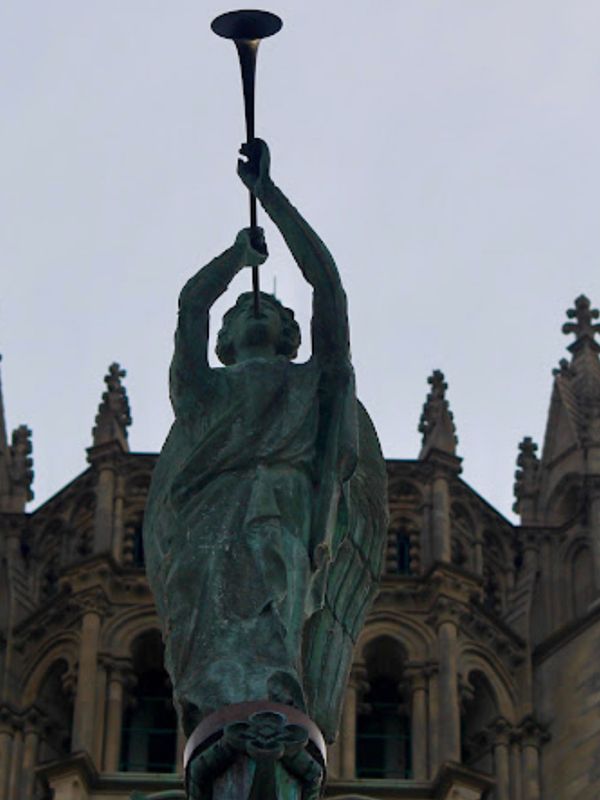
Just above Riverside Church’s Nave is Angel with the Trumpet, a copper statue installed as part of the original 1930s construction of the tallest church in the United States. Jutting into the air on the ridge pole of the roof, the statue has often been mistaken for the Archangel Gabriel, herald of visions, because of its horn.
In February 1996, during a winter storm with 45-mile-per-hour winds, the horn of the statue blew off and damaged a white Mercedes parked nearby. The car was repaired but the horn was unfortunately irreparable. A new horn was cast and installed in 1997. The original trumpet is encased and on display in the Riverside Church Archives room.
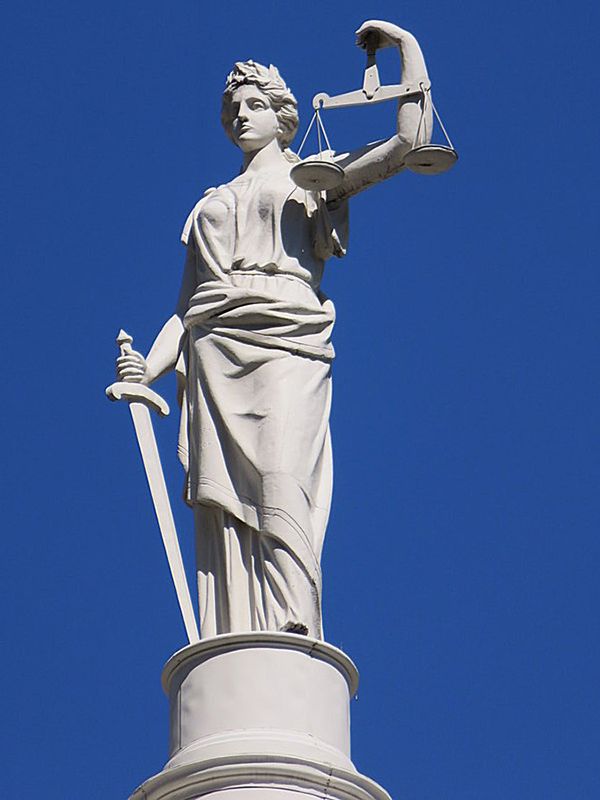
Lady Justice is a popular figure that tops municipal buildings in the Western world. This personification of justice is often depicted holding a scale to represent fairness and balance under the law; her occasional blindfold represents impartiality. Draped in a Greco-Roman toga, New York’s Lady Justice atop City Hall holds a scale in her left hand but wears no blindfold. A sword in her right hand symbolizes swift justice.
The present statue is the Federal-style building’s third Lady Justice. The first two Lady Justices, both made of wood, have been lost — one to a rooftop fire and the other to deterioration. The current statue was restored in the 1990s during the City Hall Restoration Project. From a distance, the statue appears to be made of stone, but it is actually made of lightweight sheet copper on a stainless steel armature. William H. Mullins mass-produced the sculpture in the late 1800s and sold it for $600.
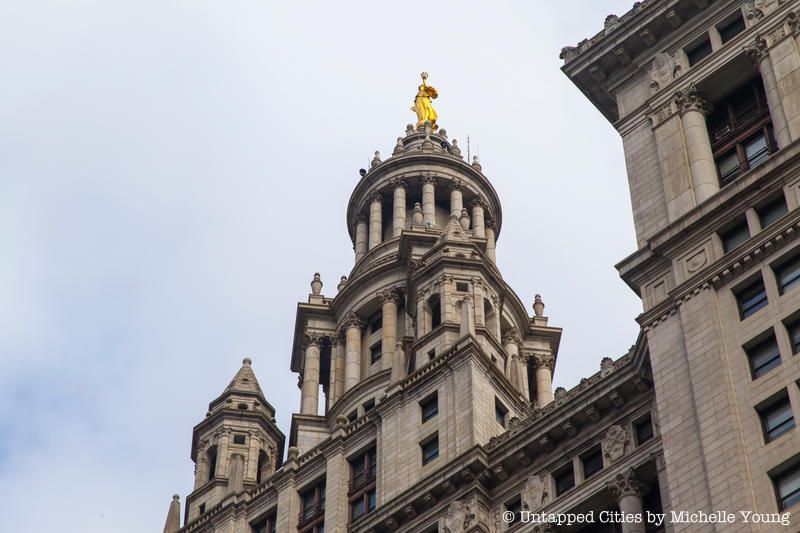
This gilded statue upstages its utilitarian sister statue, Lady Justice at City Hall, in size. Sitting on top of a 40-story building, the 25-foot tall statue is likely the city’s highest statue. The Roman goddess holds a laurel branch and wears a five-notched crown representing the five boroughs.
Sculptor Adolph A. Weinman designed the statue in 1913. Civic Fame cost $5,000 to construct, with gilding adding another $1,000 to its final cost. The statue was given a new coat of gold leaf in 1974 at a price of $42,000. Weinman chose the legendary Audrey Munson as his model for Civic Fame. Munson is known as ‘America’s first supermodel’ for the sheer number of statues for which she posed.
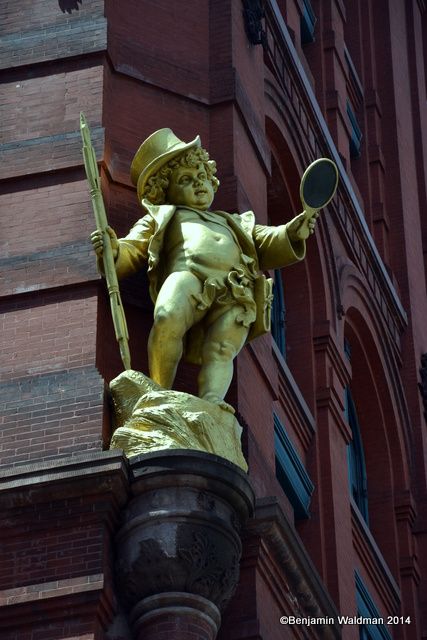
The gilded, cherub-faced dandy named Puck sits on a pedestal embedded midway up the edge of the late 19th-century industrial building of his namesake. The publisher of Puck, a notable American humor magazine, built that building that would house their magazine and the J. Ottman Lithographic Company. Ottman printed the magazine, where Puck was featured on the masthead.
The statue was created by a relatively unknown German sculptor named Henry Baerer. However, Puck’s co-founder Joseph Keppler, created the original design for the mounted statue. It is said that his little daughter posed for his design.
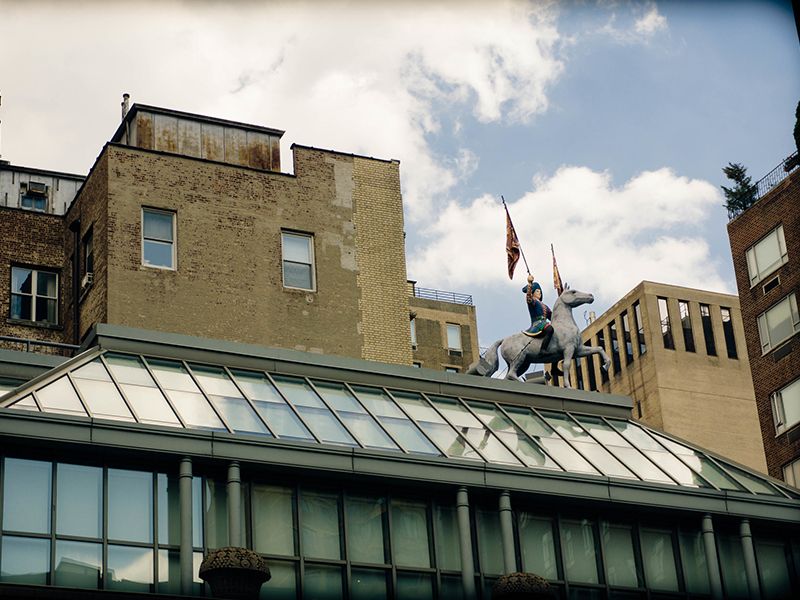
Across the street from its old location, Hermes is preparing to launch a new store in September, and one hopes its iconic rooftop statue will survive the move. The statue is not of Hermes at all but of a Napoleonic figure riding a white horse. The figure, known as “l’artificier,” shares the limelight with a horse because the store was founded in 1837 as a saddlery company. The modern Hermes logo depicts a horse and carriage, which falls in line with clothing items the brand is known for: equestrian pieces and supplies—and, of course, quality silk scarves.
The l’artificier appears on several international Hermes rooftops, most recently in Singapore. The figure made its original appearance at the Paris flagship store in celebration of the 150th anniversary of the company. Those aren’t flags the horseman waves but two Hermes scarves.

A “real” Hermes statue stands above the 42nd Street façade of Grand Central. The wing-hatted, semi-nude messenger god is flanked on its lower sides by the god Hercules and the goddess Minerva. French sculptor Jules Félix-Coutan, then president of the Académie des Beaux-Arts, designed the sandstone triad. He constructed the statues on the finished building in 1914 more than a year after the station was completed. At the time, it was the largest ‘sculptural group’ in the world.
Félix-Coutan never took the opportunity to see his final work. He made the prototype in France and sent it to America for construction. When invited to New York to see his creation, he declined, saying “I fear that the sight of some of your architecture would distress me.”
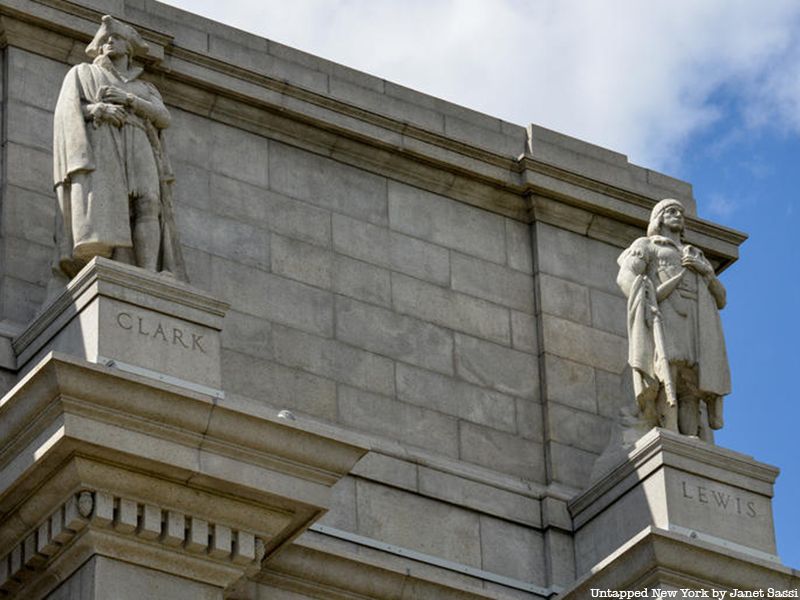
Granite likenesses of explorers Daniel Boone, John James Audubon, Meriwether Lewis, and William Clark stand above the columns of the American Museum of Natural History’s main entrance. American sculptor James Earle Fraser constructed each of the 13-foot statues as part of a façade addition built in the 1930s to honor Theodore Roosevelt.
Besides the four naturalists, Fraser also made the entrance statue of Teddy Roosevelt on horseback flanked by an African person and a Native American walking alongside. The de Blasio administration removed the statue in January 2022 for its suggestion of racial inferiority. Fraser also designed the Buffalo Nickel, a nickel produced by the United States Mint from 1913 to 1938.
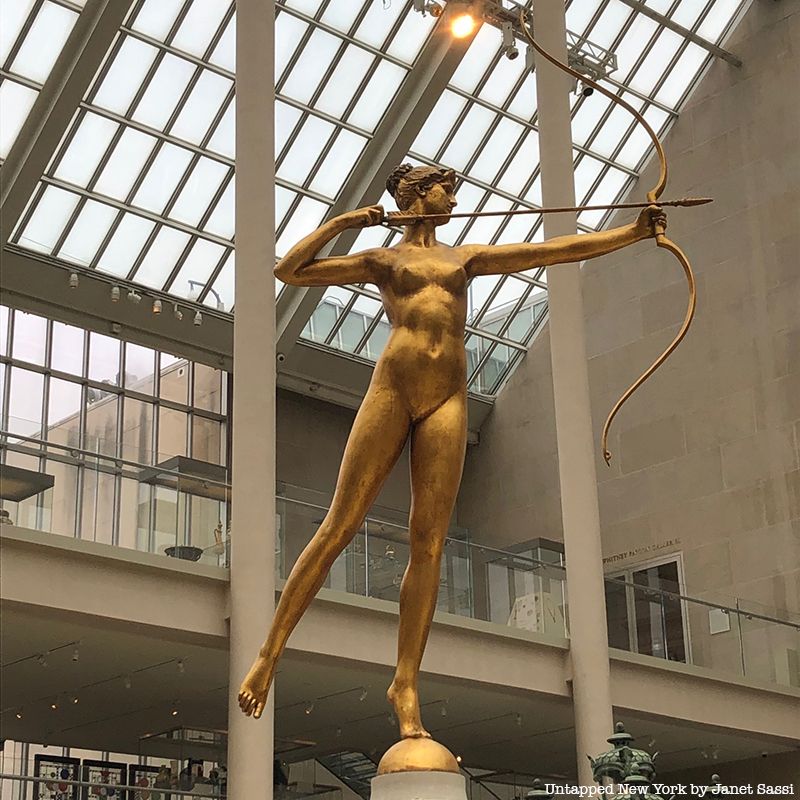
As architectural taste has morphed from concrete effigies in the human likeness to sleek-lined abstract sculpture and angular design, some rooftop statues have found homes in museums. One such sculpture is a 13-foot copper statue of the Roman goddess Diana on tiptoe, drawing her hunting bow. The statue was a rotating weathervane atop the original Pennsylvania Station from 1893 until 1925, when the station was demolished. The original — the only female nude sculpture designed by Augustus Saint-Gaudens — is housed in the Philadelphia Museum of Art.
A half-size bronze cast is displayed in the Metropolitan Museum of Art’s American Wing. Similar to City Hall’s Lady Justice, Diana of the Tower was constructed by the William Mullins Studio, but it was a custom piece commissioned by the Pennsylvania Station architect Stanford White. The original Diana was in place on a night in 1905 when White was shot to death in the building’s theatre in a sensational lovers’ triangle. The murder was dubbed ‘The Crime of the Century’ in the newspapers.
Next, check out the locations of Grand Central’s original eagles!
Subscribe to our newsletter